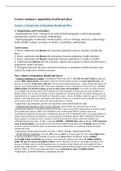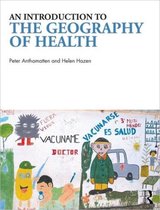Lecture summary: population, health and place
Lecture 1: Introduction to Population Health and Place
1. Organization and Practicalities
- Interdisciplinary focus: concepts from medical/health geography; medical demography;
epidemiology, medical sociology; anthropology.
- Health geography is inherently interdisciplinary: (micro-) biology, medicine, epidemiology/
Public Health, ecology, sociology, economics, psychology, anthropology.
Course aims:
1. Know, understand and discuss the important population issues in relation to health and
place.
2. Know, understand and discuss the interactions between population, health and place.
3. Know, understand and discuss inequalities between populations in relation to health.
4. Understand and discuss the role of (social, cultural and economic) context and behaviour in
populations’ health and place.
5. Distinguish between the macro and micro processes in population, health and place, and
explain the implication of these processes.
News related to Population, Health and Space:
- Cholera Outbreak in Yemen: According to WHO (July 2017): 297,438 recorded Cholera cases and
around 1800 related deaths, still updates from the Yemeni health ministry and non-reported cases. All
but one of Yemen's 23 provinces affected. The four most affected provinces - Sanaa, Hudaydah, Hajja and
Amran - have reported almost half of the cases. Outbreak is direct consequence of the civil war, with 14.5
million people cut off from regular access to clean water and sanitation. Over 50% of health facilities
are no longer functioning, almost 300 facilities have been damaged or destroyed, and some 30,000 local
health workers who are key to dealing with the outbreak have not been paid for 10 months. Rising rates of
malnutrition have weakened the health of vulnerable people - above all children under the age of 15 and the
elderly - and made them more vulnerable to the disease. There are no medical services/health care facilities
in the western part of Yemen and in the eastern part there is a desert.
• importance of sanitation, health care facilities and trained medical staff.
- Outbreak and Spread of Zika Virus in Brazil: End of 2014: first reported cases of acute
(exanthematic) disease in Northeast Brazil, March 2015, Zika Virus (ZIKV) determined as causative agent
of (exanthematic) disease. ZIKV also identified in the cerebrospinal fluid of patients with acute
neurological syndromes and previous exanthematic disease. End of September 2015, increasing number of
infants with small head circumference or microcephaly in Northeast Brazil. ZIKV identified in blood and
tissue samples of a newborn and in mothers who had given birth to infants with microcephaly and
ophthalmological anomalies. In 2015, estimated 440,000 - 1,300,000 Zika cases in Brazil. 4,783 suspected
cases of microcephaly, most of them in the Northeast of Brazil associated with 76 deaths. Spread of Zika
to other countries around the globe. In the eastern part of Brazil there is a rainforest and the mosquito
transmit the virus.
• importance of housing situation, income, climate change, migration/mobility.
- World Obesity Epidemic: In 2014, 39% men and 40% of women aged 18+ were overweight (BMI ≥
25 kg/m2) and 11% of men and 15% of women were obese (BMI ≥30 kg/m2). Nearly 2 billion
overweight adults worldwide and, of these, more than half a billion were obese. 41 million children
under the age of 5 were overweight or obese in 2014. Marked increase in overweight and obesity over
the past 4 decades most of world population lives in countries where obesity and overweight kill more
people than undernutrition -> more overnourished than undernourished people in the world (Gardner and
Halweil 2000). In 2010, overweight and obesity were estimated to cause 3·4 million deaths.
• importance of health behavior, education income.
,- Dementia and Alzheimer’s Disease: Worldwide around 47 million people with dementia, additional
9.9 million new cases every year. Alzheimer's disease accounts for 60-70% of dementia cases. One in
three cases of Alzheimer’s disease worldwide is preventable, risk factors are lack of exercise, smoking,
depression and poor education. Dementia is one of the major causes of disability and dependency among
older people worldwide. Dementia has physical, psychological, social, and economical impact on carers,
families and society.
• Importance of care provision, family arrangements, age.
Dual link geography & health:
- Spatial differences in health.
- Global differences in health (e.g. sub-Saharan Africa vs Europe).
- Comparison of disease rates in regions (e.g. Eastern vs Western Europe).
- Specifics of locations (e.g. slum areas).
- Within-country variation (e.g. urban-rural differences.
- Where you live affects your health and the health care you get.
- Spread of diseases.
- Mobility/migration and health.
- Role of place on health (therapeutic landscapes).
- Also: influence of health on place.
Geographical concepts:
- Space/location: measurable place (e.g. with GPS) it is located on a map.
- Primarily spatial definition of area.
- Place (meaning & value): what a space means to you, places are unique to individuals – the
meaning is different for different people.
- Distance (e.g. access to clear water).
- Spatial scale: level of observing (e.g. global, neighborhood, country).
- Time: how long it takes, time between moments.
- Environment:
o Natural environment: the components of the environment such as soil, air
(atmosphere), vegetation (forest) and water.
o Social environment: aspects of human behavior and organization that comprise the
social structures within which we live (politics, economics, culture).
o Build environment: human-constructed parts of the landscape such as buildings, dams,
and roads.
2. Introduction to Population, Health and Space
Topics and Concepts in health and geography
Health:
- ‘’A state of complete physical, mental, and social well-being and not merely the absence of
disease or infirmity’’ (WHO Constitution 1948).
- But: often measured as absence of disease.
- The WHO definition is absolute and hardly achievable.
- Problem: ageing population and increasing burden of chronic diseases.
,- New attempt: ‘’The ability to adapt and self-manage in the face of social, physical, and
emotional challenges’’ (Godlee, 2011).
- Subjective vs. objective measures of health: health as social construction.
- Health vs. wellbeing as individual experience.
- Quantitative vs. qualitative approaches: explaining and understanding phenomena.
Disease:
- Disease: refers to a medical conception of pathological abnormality which is indicated by a
set of signs and symptoms.
- At the population level: morbidity and mortality.
o Disease: medical conception of pathological abnormality which is indicated by a set of
signs and symptoms – implies biomedical cause and often already known treatment.
o Illness: individual’s experience of ill-health, indicated by the person’s feelings of pain,
discomfort and the like – wide concept that may refer to temporary mild problems to
long lasting severe problems.
o Sickness: social consequences/role attached to the (health) problem by society at large
– sick leave etc.
- Consequences of diseases:
o Impairment: defective or missing body part (organ level).
o Disability: inability to perform an activity (person level).
o Handicap: disadvantage that limits or prevents the fulfilment of a role (societal level).
- Mortality, morbidity.
- Incidence, prevalence.
Chronic and acute diseases:
Acute disease Chronic disease
Relatively rapid onset Slow onset
Rapid progression Slow progression
Short duration Long-lasting or life-long
Relatively direct causation Relatively complex etiology
, Infectious/non-infectious diseases:
o Infectious/communicable/contagious disease: causes by pathogens (e.g. viruses,
bacteria, parasites) that invade the body. Spread from one person or species to another
(direct, indirect).
o Non-infectious/non-communicable disease.
o Degenerative disease: deterioration of organs, cells, and tissues; by-product of ageing
process; (e.g. cancer, cardiovascular disease, diabetes); contrary to infectious diseases.
o Man-made disease.
The dual link between geography and health
1. Spatial approaches:
- Assessing the distribution of grocery stores by socioeconomic characteristics of
neighbourhoods.
- Analysing the distribution of services for the homeless in Vancouver, Canada.
- Analysing the regional availability of medical resources on preventable mortality.
- John Snow (1854): cholera in London. He marked places where people take the water from.
2. Ecological approaches:
- The impact of the development of irrigation on the spread of schistosomiasis.
- The impact of insecticide-treated bed nets in curbing malaria transmission.
- The role of occupational exposure to particulate matter in the development of lung cancer
among miners.
3. Social approaches:
- Language as a barrier to healthcare access for Turkish immigrants in Germany.
- The influence of race on incidence of stroke in Auckland, New Zealand.
- The influence of disparities in wealth on the global distribution of healthcare providers.
- The role of community gardens as place of healing.
- The importance of the internet in creating spaces for interaction between physically impaired
and able-bodied teenagers.






